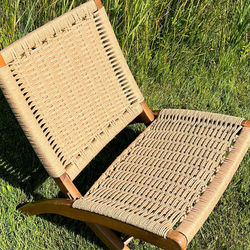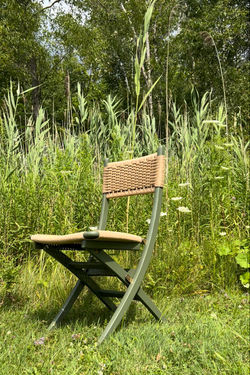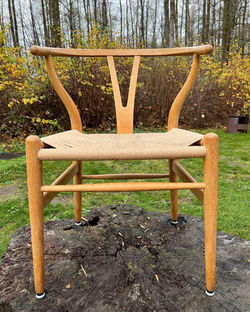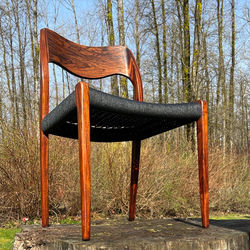Danish Cord
Blog Posts
Welcome to Caning Canada!
At Caning Canada, we are passionate about furniture weaving and providing our customers with high-quality materials. We specialize in Danish cord, a versatile and durable material for weaving chairs, stools, and other furniture. The paper cord used at Caning Canada is made of FSC-certified, sustainable materials. We use three different colours of paper cord. Natural paper cord made of unbleached paper; white paper cord which has been bleached, and black cord which has been dyed.

Moller 71 Chair woven in natural or beige Danish cord

Moller 71 Chair woven in black Danish cord

Moller 71 Chair woven in white Danish cord
Danish cord gauges and profiles:
Caning Canada stocks both laced and unlaced Danish cord in the standard gauge and laced Danish cord in the natural larger gauge.
The unlaced Danish cord is used to weave many chairs, including those designed by Moller and Wegner's Wishbone chair.

Wegner's Wishbone Chair natural unlaced Danish cord

Moller Chair 76 natural unlaced Danish cord
The laced Danish cord is used to weave Wegner's Dining Chair 23, Poul Cadovius Pia chair, Poul Volther's Chair 361, and Yugoslavian folding chairs as examples.




We use the larger gauge laced Danish cord using a no-nail technique when weaving unobstructed chair frames like Cloverleaf, Porch and converted dining chairs.





History of Danish Cord:
Danish cord, also known as paper cord or weave cord, has a rich history that dates back to the 1940s in Denmark. Thanks to its strength and flexibility, it gained popularity as a material for seats and backs of furniture. Danish cord quickly became a favourite choice for designers and craftsmen due to its ability to create intricate patterns and unique designs. Today, it continues to be a timeless choice for those who appreciate the beauty of woven furniture.
At Caning Canada, we take pride in offering high-quality Danish cord that meets the standards of professional craftspeople. Our Danish cord is sourced from trusted suppliers, ensuring its integrity and durability throughout the weaving process.
Whether restoring a vintage piece or creating a new masterpiece, Danish cord is an excellent choice for furniture weaving.
Please browse our range of Danish cord options and elevate your furniture with this remarkable material's timeless beauty and durability. Experience the art of weaving with Caning Canada today!


Danish Cord Weaving
Material Details:
Danish paper cord is a twisted paper cord used to weave furniture since the 1920s.
The Danish cord is a robust 3-ply paper product made with wood fibres. With regular use and proper care, it is estimated to last up to 60 years. See below for Danish paper cord care and maintenance. The cord is slightly waxed to resist dirt and stains.
Danish modern furniture gained popularity after World War II in Denmark and other European countries.
It offers several key advantages:
1. Durability: The Danish cord is known for its exceptional strength, making it a long-lasting choice for weaving projects. It can withstand heavy use and retain its shape and strength even after years.
2. Flexibility: The Danish cord's flexibility allows for easy weaving, enabling intricate patterns and designs to be beautifully created. This versatility makes it suitable for various furniture styles, from vintage to modern.
3. Comfort: The woven nature of the Danish cord provides a comfortable seating experience. The cord has a slight give, adapting to the body's shape, ensuring a supportive and pleasant sitting experience.
4. Aesthetics: The Danish cord brings furniture a unique and visually appealing touch. Its natural, earthy tones add warmth and character to the overall design. Additionally, its intricate patterns can enhance the beauty of any piece of furniture.

From the underside of the chair, specialty hook nails attach the cord. These nails are referred to as Danish hooks or "L" nails.
Danish hook nails are designed specifically for Danish paper cord woven furniture. The Danish hook nails are imported from Denmark.
If your chair has staples or other fasteners, it's okay. Caning Canada can supply and install the Danish hook nails for a small fee before restoring the cord.


My Danish cord chair is breaking at the front and back edges. Can you fix the broken pieces?
The front and back runs of the Danish cord tend to be breaking points of this type of furniture after long-term use.
Once these pieces of material break, it is time to replace the Danish cord surface.
Contact Caning Canada to have your Danish cord chair repaired.


Single Rail Danish Cord Weaving
Danish cord weaving is typically one-sided and only wraps around a single rung on all sides.
This weaving pattern is referred to as the basket weave.

Double Rail Danish Cord Weaving
The CH 23 dining chair was one of the first chairs Hans J. Wegner designed exclusively for Carl Hansen & Søn in 1950 at age 35.
The CH 23 chair incorporates many sophisticated details; the most notable for a seat weaver is the double-rail woven seat.
Double Danish cord has an extra step in the weaving process where the weaving wraps around two rungs, and all the Danish cord material is pulled through the vertical wraps.



Danish Cord Woven in the Rush Pattern or Envelope Weave
Some chairs are woven in the rush pattern or envelope weave using Danish cord material.
The rushing pattern Danish cord mimics traditional rushing with the Danish cord material.
In 1949, Wegner adapted an existing technique known as "envelope weaving" to the Danish cord.
Often, these chairs have extensive slots that the Danish cord must be fed through, which makes weaving these seats more labour-intensive.
Examples of this style of Danish cord chair include the CH 24 Wishbone or “Y” Chair, designed by Wegner and initially released in 1949, and the Model 316 Chair by Peter Hvidt & Orla Mølgaard Nielsen for Søborg Møbelfabrik 1958.

Wishbone Chair Special Edition Pattern
Carl Hansen & Son issued a special edition of the Wishbone chair woven using a no-nail technique.
Caning Canada loves this weaving technique and offers it not only on the Wishbone chair; we all offer this weave on other chairs originally woven using the envelope weaving technique.


Yugoslavian Folding Rope Chairs
There are different weaving techniques and patterns used for Yugoslavian rope chairs.
Most chairs are designed to accept a specific pattern.
 |
|---|
 |
 |
 |
 |
 |
 |
 |



Double Sided Danish Cord Weaving
Some chairs are woven in the rush pattern using Danish cord material.
The rushing pattern Danish cord mimics traditional rushing with the Danish cord material.
The woven backrest of Hans Wegner's Chair 25 is visible on both sides, providing visual beauty from all angles.
Beautiful from all angles — “A chair is to have no backside,” said Hans J. Wegner, designer of the Easy Chair. “It should be beautiful from all sides and angles.”
Double-sided Danish cord weaving techniques differ depending on the design of the chair.
Examples of this style of Danish cord chair include the CH 24 Wishbone or “Y” Chair, designed by Wegner and originally released in 1949, and the Model 316 Chair by Peter Hvidt & Orla Mølgaard Nielsen for Søborg Møbelfabrik 1958.

Chair Conversion to Danish Cord
If you want to breathe new life into your fabric, strapped, corded, or pleather upholstered Danish chairs with Danish cord, look no further than Vintage Chair Canada.

Danish Cord Furniture - Care
Some people spray a scotch guard on the Danish cord surfaces to stop stains from absorbing.
Paper cord typically doesn't require maintenance or very little maintenance, as the strong paper cord is designed to last for years. If you need to clean the seat, wipe it with a tightly wrung soft cloth with a neutral, colourless soap solution.
Please don't do this too often, as it can cause undo wear to the paper cord. The paper cord is treated with a thin layer of wax to help prevent stains.
Vacuuming once in a while is always a good practice.
If a stain does come on the paper cord, we recommend using a tightly wrung soft cloth to remove as much of the liquid as possible. Be careful not to rub the liquid into the paper cord, but dab the cloth gently on the stained area.
















